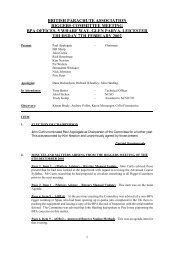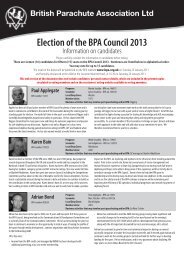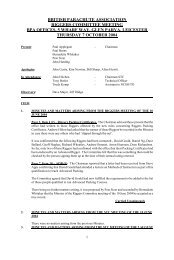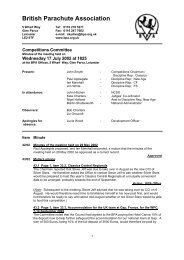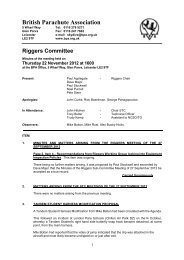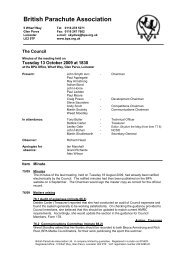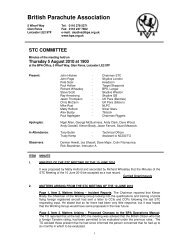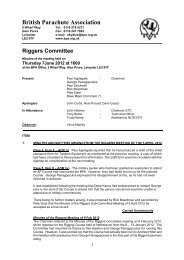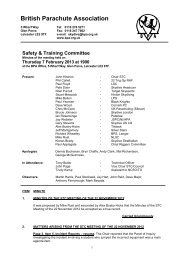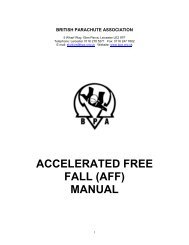Formation Skydiving Progression Manual - British Parachute ...
Formation Skydiving Progression Manual - British Parachute ...
Formation Skydiving Progression Manual - British Parachute ...
Create successful ePaper yourself
Turn your PDF publications into a flip-book with our unique Google optimized e-Paper software.
The number of “points” achievable is, in its most basic sense, proportional to the amount of freefall<br />
time available on that skydive. i.e. if you are in free-fall for twice the amount of time, with the<br />
same ability level, you should be able to achieve twice the number of points. However, it is well<br />
known that other factors can affect the “score” of a skydive, such as the exit, conditions etc., and<br />
these factors should be taken into account by the CCI when considering awarding the FS1. The<br />
following guidance is based on an average day where FS1 candidate “A”, jumping from 10,000ft<br />
without a linked exit, is able to achieve four points. In order to demonstrate an equivalent level of<br />
skill to candidate “A”, the number of points that should reasonably be expected from any other<br />
candidate from a given altitude using a linked/unlinked exit is as follows:<br />
Altitude<br />
Min Points Expected<br />
Using Linked Exit<br />
Min Points Expected<br />
Exit Not Linked<br />
10,000ft 5 4<br />
11,000ft 6 5<br />
12,000ft 7 6<br />
13,000ft 8 7<br />
14,000ft 9 8<br />
15,000ft 10 9<br />
Fig. 1 Expected Points for FS1 Qualifying Skydive<br />
The expected points above do not overwrite the requirements as described in 6.4.1 (f) of the BPA<br />
Operations <strong>Manual</strong>. However, they offer the CCI guidance when taking into account all factors on<br />
any given FS1 skydive, based on free fall altitude (and therefore, time) available.<br />
The FS1 Skydive<br />
Part of completing a good FS skydive is how it is constructed and briefed. Whilst there is no<br />
requirement to brief this skydive, it is of great benefit to understand the shapes you are going to<br />
be part of forming. This is a perfect opportunity to learn as much as you can about planning,<br />
organising, briefing and de-briefing a skydive.<br />
In most circumstances you will take the position or “slot” of “Point” although you may discuss with<br />
your coach should you have a strong desire to take a different “slot”.<br />
Considering the diagrams below, you would be the red skydiver (top right). If you have a black<br />
and white document, ask your FS coach to point out which skydiver in each formation is “Point”.<br />
Your FS1 skydive should include one of each of the following four selections to make a four point<br />
4-way.<br />
a) Bow (H) or Side-body (P) [e.g. side-ways move to formation]<br />
13



